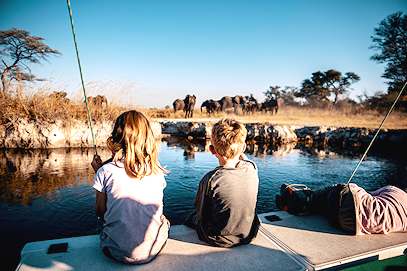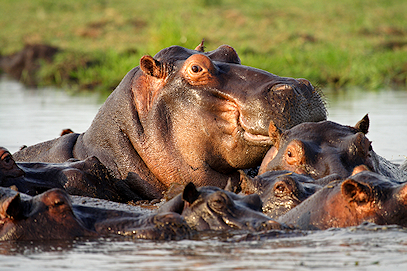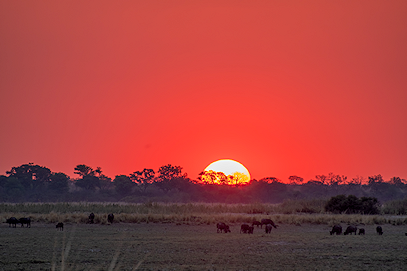Namibia'sZambezi Region
Help Me Plan- Home
- >
- African Travel
- >
- Namibia
- >
- Zambezi Region
Zambezi Region (Formerly Caprivi) Destination Guide
Fed by the Chobe, Kwando, Zambezi, and Okavango, the Zambezi Region is Namibia’s green, riverine corner. Floodplains, woodlands, and wetlands attract exceptional concentrations of wildlife and over 450 bird species. River lodges, boat safaris, and guided drives make it a rewarding add-on to Etosha or a cross-border Chobe and Victoria Falls itinerary.
Getting to the Zambezi Region
By Air: The Zambezi Region is located in the far north of Namibia, approximately 1,200 km by road from Windhoek via the paved B8 (Trans-Caprivi Highway). African Sky combines the Zambezi Region with other Namibian destinations so that the long drive can be optional.
By Road: The Zambezi Region is located in the far north of Namibia, approximately ~1,225 km from Windhoek International Airport via the recently paved Trans-Zambezi Region Highway. African Sky combines the Zambezi Region with other Namibia destinations so that the long drive will be optional.
Weather & Best Time To Visit
It's hard to determine the best time to visit the Zambezi Region, partly because Namibia experiences approximately 300 days of sunshine and partly because it depends on what your interests are. During the dry winter, from June to August, wildlife gravitates towards the watering holes and rivers; thus, game viewing is exceptional. Nights are cold, and temperatures drop significantly from their daytime highs.
January and February are the wettest and hottest months of the year and mosquito season. The summer months are the best time to view birds; newborn wildlife is abundant. We recommend visiting from September to December to enjoy the best of both seasons.

This area has several safari lodges, and visitors will love all the outdoor activities, like fishing, river cruises, game-viewing safaris, and walks with a professional guide. Mahango Game Reserve, Caprivi Game Park, and Mudumu National Park are all in the area. The area is rich in animal life.
Reasons to visit Zambezi Region
A Remote Oasis
The Zambezi Region starkly contrasts with the rest of Namibia; its reserves are almost incomparable to other parks, such as Etosha. Its lush, green, well-watered areas, and even its strange finger-like shape, is truly an escape from the dry Namibian lands to the west and south. It borders Botswana and Angola.
River Quartet
The area's rivers attract many animals and birds, and they embellish the region in near-tropical green conditions. Zambezi Region offers a range of water-based activities and spectacular sunsets accompanied by sightings of animals like hippo and crocodile.
Best Kept Birding Secret
The area is an Eden for birds and a must-visit for birding enthusiasts. More than 450 different species occur across the region. The African fish eagle and its evocative call can be heard from miles away, and seeing it swoop into the fresh waters to catch fish is unforgettable.
Experiences to Savor
The Zambezi Region region's untamed nature extends to the experiences on offer to travelers.

Relaxing by the River
The rivers are a constant source of serenity. You can enjoy the view from the various lodges or an array of boats, including houseboats, which wade up and down the rivers while passing a multitude of animals. Moreover, sunrise and sunset on the waters are like something out of a movie every day.
Big, Bigger, Biggest
Crocodile are often seen on the banks or in the river. It is joined by hippo, which can break a crocodile's back with its large jaws. The largest land mammal — the elephant — also frequents the area. Splashes and sounds result in heads turning to the source of the commotion.
Your Private Show
Some refer to the Zambezi Region as the Okavango of Namibia. However, it is less well-known than the latter, meaning guests will experience a more hidden, private wilderness. Enjoy secluded game drives and boat rides in this remote part of Namibia.Useful Information
History
The Zambezi Region was obtained by Namibia (at the time known as German South-West Africa) in 1890 and named after German Chancellor Leo von Caprivi, who negotiated the exchange of land with the British. It gave the Germans access to the Zambezi River, which they thought would provide a water passage to the Indian Ocean and a shortcut to Tanganyika — a German colony at the time. Before they knew about Victoria Falls, they abruptly stopped this venture. The acquisition of the Caprivi Strip was part of the Heligoland-Zanzibar Treaty, where Germany gave Zanzibar to the British and obtained the Caprivi Strip and the Heligoland Island in the North Sea.
Even though the German plan to gain access to the Indian Ocean did not work out, Namibia gained an area with exceptional natural wealth and even mineral resources. Due to the immense diversity of the fauna and flora in this area, there are currently three marvelous national parks; Bwabwata National Park, Mudumu National Park and Nkasa Rupara National Park. Bwabwata National Park was proclaimed in 2007 when the Caprivi Game Park, Mahango Game Reserve and the unproclaimed area along the Kwando River were united. Mudumu National Park was created in 1990 along with its sister park Mamili National Park, that was changed to Nkasa Rupara National Park in 2012 by the Namibian government.
Wildlife
The region is one of the few places where one can still enjoy an authentic wilderness experience. There are hardly any fences. Indigenous animals still follow their historic migratory routes. With unmatched biodiversity due to all the different biomes, the number of species is remarkable. Elephant still wade through rivers alongside hippo and crocodile. Rare antelope such as sitatunga, red lechwe, roan and sable occur here, and it also serves as a sanctuary for rare and endangered species like the African wild dog. Other predators include lion, brown hyena, spotted hyena, leopard, caracal and cheetah.
Buffalo, giraffe, zebra, reedbuck, oribi, tsessebe, duiker, impala and puku also occur in the area. Similarly, the Zambezi Region is a paradise for any birdwatcher, with more than 450 bird species. The western reaches of the Bwabwata Park have been proclaimed an internationally important bird area, supporting globally threatened bird species. It is also an avian diversity hotspot. Alluring birds in the area include the barred owlet, Bennett's woodpecker, white-backed night heron, African skimmer, African pygmy-goose and southern ground hornbill, to name a few. The area is a popular fishing destination, where anglers target highly predatory tiger fish.
Vegetation & Terrain
The Kalahari Desert covers over 900,000 km², including the most significant part of Botswana and South Africa, Namibia, Zambia, Zimbabwe and Angola. The Zambezi Region lies at the bottom of the Kalahari Basin, halfway between the Atlantic and Indian oceans. Although classified as part of the semidesert, the area is the wettest region of Namibia, and floods occur regularly in the floodplains. The area includes biomes such as marshes, riverine forests, mopane woodland, deciduous woodland, dense savanna and dunes. Generally, flat terrain and lush vegetation characterize the area as opposed to the western tree-and-shrub savannas of the more arid desert regions.
The Bwabwata National Park's vegetation is best described as deciduous woodlands. The Mudumu National Park contains savanna and mopane forest, and the Nkasa Rupara National Park is known for its wetlands and marshes. The subtropical features and the presence of the Chobe, Okavango, Zambezi and Kwando rivers allow a multitude of tree species, such as mopane, acacia, Zambezi teak, copalwood and leadwood, to prosper along the riverbanks and the plains.
Activities
The Zambezi Region allows for various methods of pristine game viewing, such as game drives through the parks, bush walks accompanied by experienced rangers, and game viewing by boat. You can also view animals from the comfort of the various lodges along the riverbanks. Water-based activities such as sunset cruises and canoeing are great ways to view the area and unwind. Houseboats on the rivers and fishing in the area are popular pastimes. Trips on traditional mokoro boats (made from the trunks of indigenous trees) accompanied by knowledgeable guides make for unique experiences.
Birding is exceptional. Hiking activities are also available in some of the areas. It is, however, best to avoid wandering off by yourself, especially in riverine areas. Hippo is common and highly aggressive and territorial. Namibia is one of the top destinations for stargazing, as the night sky is generally cloudless, so be sure to lie down and experience the marvels of our solar system.









